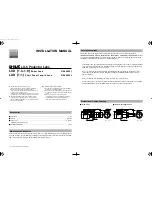
Projection Operations
8
When the projector is at an angle to the screen it is projecting on, the projected image may
have different length top and bottom edges. This phenomenon is called, “keystoning”. This
projector comes with functions for automatic as well as manual keystone correction, which
provides a regularly shaped projected image. The following shows the allowable angle that the
projector can be positioned relative to the screen.
z
The angles shown in the above illustration are subject to the following conditions.
z
Projection of an image from a computer (Resolution: 1024
×
768; Vertical Frequency:
60Hz)
z
Resize Image To Fit: On
z
Actual correction ranges are affected by the type of signal being projected, zoom, the
“Resize Image To Fit” setting, the aspect ratio setting, and other factors.
z
Keystone correction can cause the corrected image to be smaller than the original
(uncorrected) image, or it can cause distortion of the image. If the projected image
becomes difficult to view, try moving the screen and/or projector so they are oriented
close to the configuration shown under “Setting Up the Projector” in the “User’s Guide
(Basic Operations)”.
z
The projector does not support horizontal keystone correction. The center of the
projector’s lens should be aligned with the horizontal center of the screen (see “Setting
Up the Projector” in the “User’s Guide (Basic Operations)”).
Keystone Correction (KEYSTONE)
Screen
Up to about 20
degrees
Up to about 20
degrees
Summary of Contents for XJ-360 - XGA DLP Projector
Page 60: ...MA0412 A ...









































